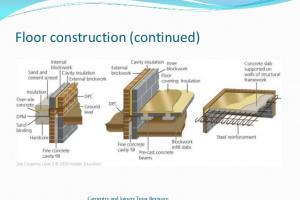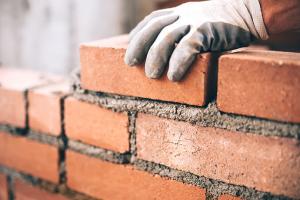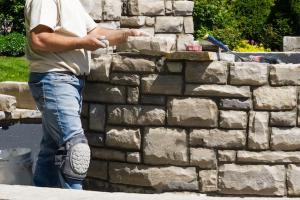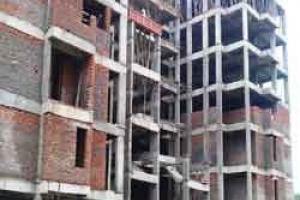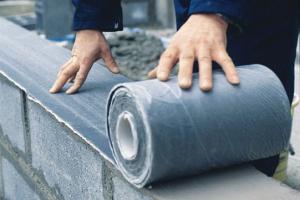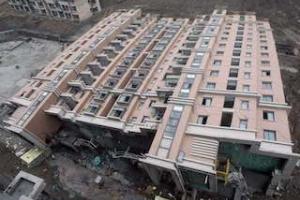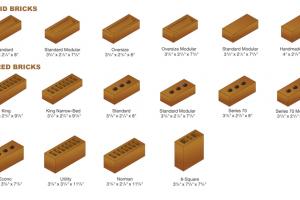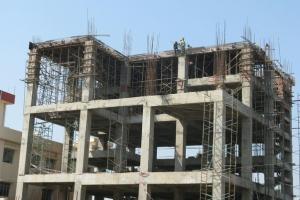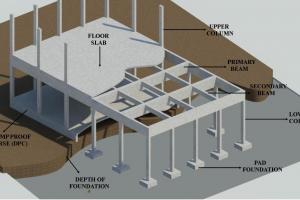Steps for How to Construct a Stone Wall

How to construct a stone wall:
Step 1: To assist in your stacking, sort the stone by size; setting aside the smallest pieces to use as shims (these will help level unsteady larger stones).
Prepare for this activity by stretching well and always lift using your arms and legs, not your back Shims (shown far right), or smaller stones, help level unsteady larger pieces.
Step 2: Map out the design by digging a trench about 6" deep and as wide as your largest stone.
Step 3: Pack down and level earth. Cut filter fabric at least 3 feet wider than the trench. Lay down filter fabric inside trench so that excess is on the backside of trench. Filter fabric keeps dirt from migrating while allowing water to drain through your wall.
Step 4: Place a thin layer of crushed stone (1"-2") in the trench to help level stones and assist drainage.
Step 5: Start with the largest stones first. Lay them flat from one end of the trench to the other. Continue to stack stones, working back and forth, one level at a time.
Step 6: As you stack your wall, make sure that it slopes back slightly to ensure stability. Position stone tightly together, mixing small and large pieces. Stagger joints between stones to create more stability.
Step 7: As you build up, fill in the area behind the wall with crushed stone, and then fill dirt, compacting as you go. Keep your filter fabric between the fill and stonewall.
Step 8:When wall is stacked to desired height, fold the filter fabric back over the fill dirt area and finish with your choice of top soil, mulch, gravel, etc. Run water to settle dirt behind the wall and into its services.
Problems in construction of buildings with stones:
Overall, it can be stated that the improved element performed better than the traditional element in the series of earthquake simulations. This statement is based on an assessment of the risk of causing injury posed by each structure. The walls of the traditional corners were independent and unstable.
Any additional force, such as another tremor or a strong wind or impact, could cause either wall to topple over, in an inward or outward direction. This represents an unacceptable level of risk. These buildings are one of the most deficient building systems from earthquake-resistance point of view. The main deficiencies include excessive wall thickness, absence of any connection between the two withes of the wall, and use of round stones.
Factors to be considered in stone construction
- Important buildings were once designed and put together by master masons who knew how to work with stone, and understood the advantages and limitations of the material. Stone structure should be a combination of structural firmness, technical commodity and aesthetic delight.
- Ensure proper wall construction. The wall thickness should not exceed 450mm.
- Round stone boulders should not be used in the construction! Instead, the stones should be shaped using chisels and hammers.
- Use of mud mortar should be avoided in higher seismic zones. Instead, cement-sand mortar should be 1:6 (or richer) and lime-sand mortar 1:3 (or richer) should be used.
- Ensure proper bond in masonry courses: The masonry walls should be built in construction lifts not exceeding 600 mm.
- Through-stones (each extending over full thickness of wall) or a pair of overlapping bond-stones (each extending over at least ¾ this thickness of wall) must be used at every 600mm along the height and at a maximum spacing of 1.2m along the length.
- The stone masonry dwellings must have horizontal bands roof and gable bands). These bands can be constructed out of wood or reinforced Concrete, and chosen based on economy. It is important to provide at least one band (either lintel band or roof band) in stone masonry construction.
- Care should be taken to ensure that the fixing method adopted for the construction is appropriate to the type of stone being used.
The energy needed to collapse a structure comes from the structure itself. The high frequencies can cause high vertical inter-stone vibrations that result in irreversible relative displacements of the stones, which is mainly due to the non required shape of the stones, thus stone walls mainly crumble under their own weight.



